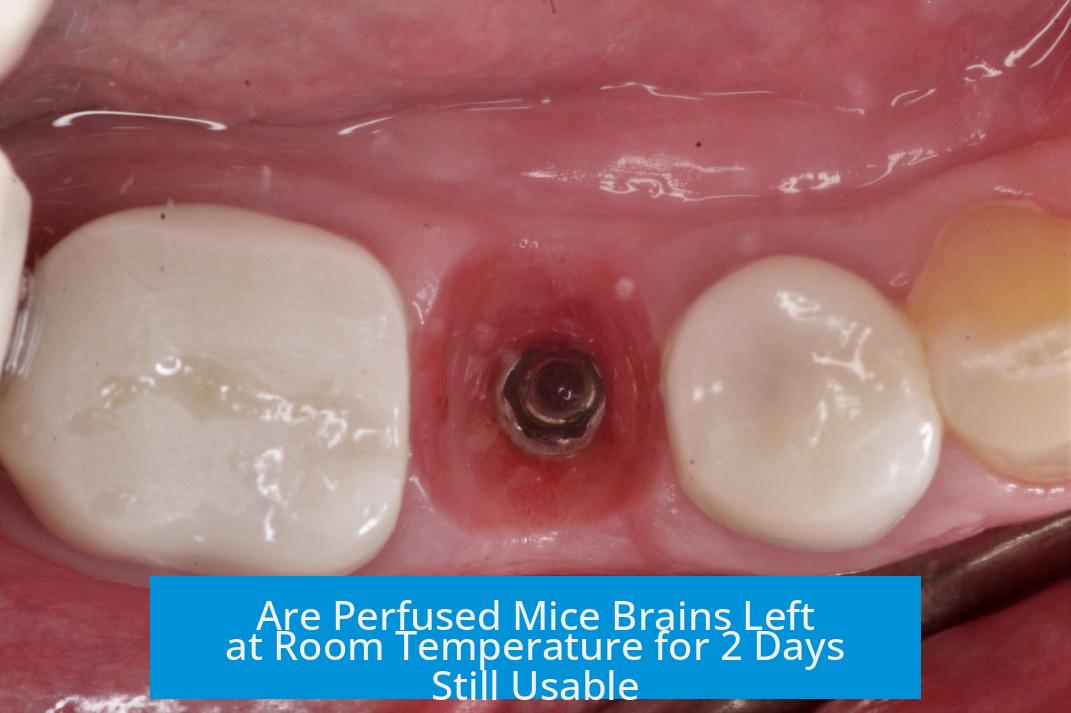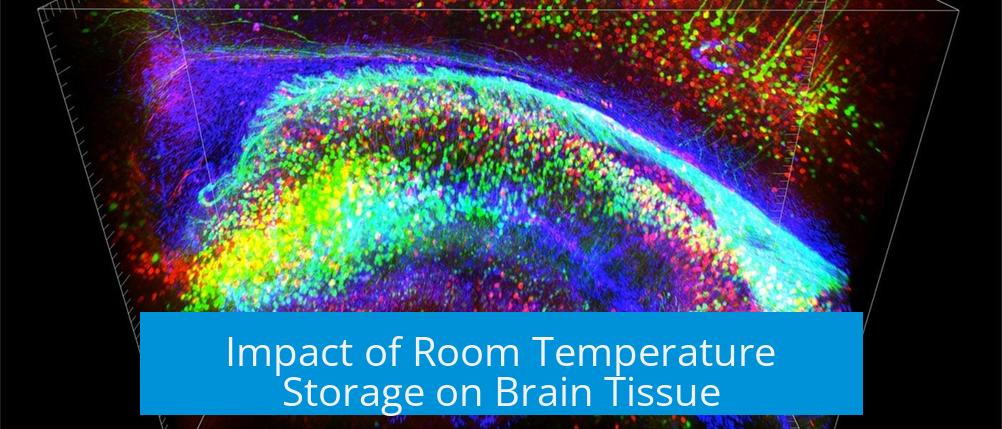Are Perfused Mice Brains Left at Room Temperature for 2 Days Still Usable?

If mice brains were left at room temperature for two days after perfusion, their usability depends critically on the fixation method used. Properly fixed brains (e.g., with paraformaldehyde) may still be usable, but unfixed or only sucrose-stored brains generally cannot yield reliable data and should be discarded.
Impact of Room Temperature Storage on Brain Tissue

Brain tissue left at room temperature for 48 hours undergoes extensive degradation. RNA, DNA, and proteins break down rapidly. Cellular structures lose integrity, leading to data artifacts. These molecular changes compromise downstream analyses like immunohistochemistry or RNA profiling.
Role of Fixation Methods
- Fixed Tissue (PFA or Formaldehyde): Proper perfusion with paraformaldehyde crosslinks proteins and stabilizes tissue. This preservation can tolerate short-term room temperature exposure, keeping brains usable for histology or molecular assays.
- Unfixed Tissue: Tissue that was not chemically fixed faces rapid autolysis and microbial contamination. Such brains lose structural and biochemical integrity, making them unsuitable for reliable results.
Risks of Sucrose Storage Without Fixation
Sucrose solutions mainly serve to cryoprotect and do not inhibit degradation or bacterial growth effectively. Prolonged storage in sucrose without fixation promotes enzymatic breakdown and contamination. Adding sodium azide can curb bacterial growth but does not reverse tissue degradation.
Guidance on Tissue Usability
- If the brains were only perfused but not fixed, discard them to avoid compromised data.
- Brains fixed properly with PFA may still be viable but must be checked carefully.
- Controls in downstream assays like immunohistochemistry are essential to detect artifacts caused by tissue deterioration.
- Starting anew with fresh, properly fixed brains is advisable to save time and resources.
Key Takeaways
- Extended room temperature storage causes molecular and cellular degradation in brain tissue.
- Proper fixation with PFA or formaldehyde is critical for tissue preservation.
- Unfixed or sucrose-only stored brains after two days at room temperature are unreliable.
- Discard compromised tissue to avoid faulty experimental results.
- Use stringent controls to identify artifacts in remaining samples.
Forgot My Perfused Mice Brains at Room Temperature for 2 Days, Are They Still Usable?
Short answer? If those mice brains just chilled at room temperature for 48 hours without proper fixation, they’re pretty much a no-go. Sorry to break it to you, but molecular decay has already set in, spoiling your samples and likely ruining any hopes of reliable data.
Now, before you start blaming your memory, let’s unpack why leaving perfused mice brains out at room temperature for two days is a recipe for scientific disappointment — and what, if anything, can salvage the situation.
The Molecular Meltdown: What Happens When Brains Just Sit Around
Imagine your mouse brain as a bustling city. Once perfused and freshly preserved, the cells and molecules are going about their business, DNA intact, RNA crisp, and proteins holding shape. Leave them out for two days at room temperature, though? Chaos ensues.
Over this time, molecular decay kicks into overdrive. RNA degrades quickly, DNA strands begin to break, and proteins lose their structure. Cellular integrity crumbles. These types of changes are not subtle or minor — they are profound.
The result? When you analyze these brains, you’ll be staring at artefacts rather than biological truth. Your data become compromised, unreliable, a bit like trying to decipher a book with pages missing and ink smudged.
Sucrose Storage Without Fixation: A False Sense of Security
Some might think that simply storing brains in sucrose protects them. Unfortunately, sucrose isn’t a magical preservative. While it helps with osmotic balance, it won’t stop those deadly degrading enzymes from doing their job. Your brains are still basically rotting.
Even worse, sucrose can inadvertently foster bacterial growth when left unrefrigerated. Picture a bacterial party crashing your samples. If you decide to store them further, adding sodium azide can inhibit bacterial expansion — provided it doesn’t interfere with your downstream antibody reactions. A small silver lining, but it’s patchwork at best.
The Lifesaver: Proper Fixation Methods
The type of fixation used matters enormously. If your mice brains were perfused and properly fixed with paraformaldehyde (PFA), you stand a better chance. PFA crosslinks proteins and stabilizes tissue architecture, locking molecules in place like a snapshot. Brains properly fixed with PFA can survive delays and still yield usable data.
Brains fixed with formaldehyde also show better resilience but don’t expect a miracle. Without fixation — that is, if tissues were just perfused but never chemically stabilized — your samples are unfortunately junk after two days at room temperature.
Ask yourself: Was the brain just perfused with saline or buffer, or was fixation part of the step? This question can save you hours, and frustration, down the line.
Should You Even Bother Trying?
If your brains weren’t fixed or properly stored, the harsh truth is this: Processing them further is a waste of time and resources. You’ll likely find yourself chasing artefacts. And while it’s tempting to salvage something from this mishap, science demands integrity.
Better to cut your losses, discard those samples, and start with fresh brains properly perfused and fixed. Your future self, and those poor mice, will thank you.
Tips to Avoid This Pitfall in Future Experiments
- Fix Immediately: Always perfuse with fixative such as 4% PFA right after euthanasia.
- Cold Storage: Store brains at 4°C promptly if not freezing, reducing enzymatic degradation.
- Use Sodium Azide: Include sodium azide in storage solutions to minimize bacterial growth when applicable.
- Immunohistochemistry Controls: Use rigorous controls to detect artefacts if tissue storage conditions are less than ideal.
Can There Be Any Silver Lining?
If you remember the specifics of your protocol and confirm proper fixation with PFA or formaldehyde, proceed cautiously. Performing pilot tests with control tissues can help determine if any usable signals remain. After all, sometimes science is about testing boundaries, yet knowing when to cut bait is equally important.
Otherwise, it’s time to face the music. Let’s channel that scientist spirit — learning from the mistake, optimizing fixation and storage methods, and moving forward with confidence.
In Conclusion
Brains left at room temperature for two days experience substantial molecular and cellular degradation impacting RNA, DNA, and protein integrity. Sucrose alone does not prevent this decay and may encourage bacterial growth. Only brains fixed properly with PFA or formaldehyde might still be usable; unfixed samples should be discarded. To ensure valid data and avoid artefacts, prioritize fixation and proper storage. And when in doubt, fresh tissue beats mushy, artefactual samples every time.
So next time, label your samples, set alarms, and maybe keep a sticky note saying, “Brains do NOT like room-temperature naps.” Your future scientific self will nod in grateful agreement.
Can perfused mice brains left at room temperature for 2 days still be used for experiments?
If the brains were properly fixed with PFA or formaldehyde, they might still be usable. However, if they were unfixed or only perfused without fixation, they are highly likely degraded and not useful for reliable results.
Does storing brains in sucrose prevent degradation after 2 days at room temperature?
No. Sucrose does not stop tissue degradation or bacterial growth. After 2 days at room temperature, sucrose storage alone is insufficient to preserve the brains, increasing the risk of data artifacts.
What molecular changes occur in brains left out for 2 days at room temperature?
Significant RNA, DNA, and protein degradation happens. These molecular changes compromise tissue integrity, causing unreliable results and artefacts in further analysis.
Is it safe to use brains left in sucrose without fixation for immunohistochemistry?
No. Such tissue will likely give false signals and artefacts. Proper controls are critical to detect these, but discarding the tissue and starting fresh is recommended.
Can adding sodium azide help preserve brains left at room temperature?
Sodium azide might slow bacterial growth but won’t reverse tissue degradation. It may interfere with some antibodies, so it’s only a partial solution if you must store longer.





Leave a Comment